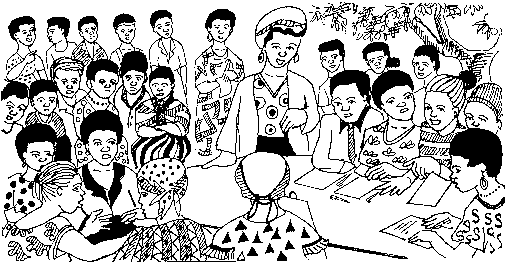Tweet
Translations:
'العربية / al-ʿarabīyah
বাংলা / Baṅla
Català
中文 / Zhōngwén
Deutsch
English
Español
Filipino/Tagalog
Français
Galego
Ελληνικά / Elliniká
हिन्दी / hindī
Italiano
بهاس ملايو / Bahasa Melayu
Polszczyzna
Português
Română
Telugu
Tiếng Việt
Türkçe
Other formats:
Other Pages:
Modules
Site Map
Key Words
Contact
Utility Documents
Useful Links
DEFENDING THE METHODOLOGY
by Phil Bartle, PhD
Managers' Notes
Advocating participation by the community in appraising itself
Assumptions and Ignorance:
There are many people who mainly want to see the physical construction of a community facility. Among those who have an impact on your work are many politicians, journalists, project managers and engineers. The facility (eg water point, latrine, school, clinic) is visible, easy to photograph (next to a politician) and concrete. It is easily verified as proof of achievement. Taking time to have community members participate in appraisal (along with other capacity development: training in planning, management, accounting, monitoring, reporting, repair, maintenance) is not so visible. How do you photograph a capacity development?
(I once had an embassy secretary get very angry when a visiting donor agency official was flying into a country for three days the following week, and there were no community participation events available to visit).
Project managers know that, no matter what the written objectives are on the project document, they will be judged publicly according to the construction of physical facilities. Not everyone assumes that physical construction is paramount. There are also those who are open minded enough to be willing to be convinced that the capacity development aspect is as important.
You may be called upon to defend of explain the need and benefit of taking time for community participation. "Should we build a water well and pump, just to watch it fall into disuse then disrepair, because no one in the community takes responsibility to repair and maintain it?" you might ask.
Why Take the Time?
Taking the time to start with community participation (in appraisal, choosing projects, management, monitoring, and capacity development) helps to encourage community members to develop a communal sense of "ownership" of a facility.
That promotes increased responsibility for its protection (eg against vandalism and stray livestock), maintenance and repair. It makes the community more conducive to increased effective use of the facility and more receptive to complementary training (such as hygiene principles and practices).
To encourage the sustainability of physical facilities, the community participation approach, while time consuming, is more effective and positive in the long run, than mere rapid construction of the facility.
Why Collect Information Twice?
Another aspect that you may need to defend, is the purpose of information collected during the map making and inventory production.
Some detractors may ask why a community made map and inventory are necessary, especially when a comprehensive base line survey has already been conducted.
You may need to explain that the participatory collection of community information is primarily for the community. It is for promoting sustainability and responsibility. Any benefit to the project or agency is secondary, as planning data. The information collected through the community process, however, can complement, fine tune, amplify and correct data collected on a survey.
How Should You Engage in the Advocacy?
A key event which allows you to make these important pointsto those willing to listen, is any public event related to the community construction of a facility. This may be a "cheque handing over ceremony," where major donors are recognized, a "laying a foundation stone," where a VIP officially starts the construction, or a "completion ceremony and celebration," where local and national dignitaries cut a ribbon, declare the faculty complete, or kick off the first official use of the facility.
During a key event, you may hand out copies of a one-page pamphlet, emphasizing that not only is this a construction project, but is also a community capacity development project, sketching the participation of the whole community in all phases (appraisal, choosing priorities, management training, monitoring maintenance and reporting).
A slightly longer, perhaps two-page press release, can be provided to journalists (TV, radio, newspaper, government public information officer). If any understanding and sympathetic journalist also does free lance work, you may hire one to write a press release that explains the participatory approach and its benefits that outweigh the time consumed. If you have extended access to journalists (as, for example, during a visit to a remote community, sharing transportation), you can explain the methodology, and why it needs more time, in greater detail.
To be effective in your advocacy, you need to understand the approach very well, and be convinced yourself of its benefits. It is not sufficient to be prepared to defend or explain participatory approaches. Because so many assumptions are made, and often not stated, it is necessary to take a pro-active approach.
Know what kinds of people whose opinions are important to your purpose (including politicians, senior civil servants, journalists and engineers). Identify particular individuals who potentially can change from being (uninformed) hindrances to (understanding) allies. Ensure that they get copies of your pamphlets and press releases. Raise the question and introduce the subject during informal conversations wherever you get the chance.
In general, it is a fairly simple equation: participation slows down construction but promotes sustainability.
You need to be albe to explain this in more detail with specific reference to current community projects. Write your arguments in simple language to get your point across. In some ways this is the opposite of facilitating participation among community members; you identify your goal first, then get your message to your chosen recipients. It is up to you.
––»«––
Taking Time to Get Community Input:
 |